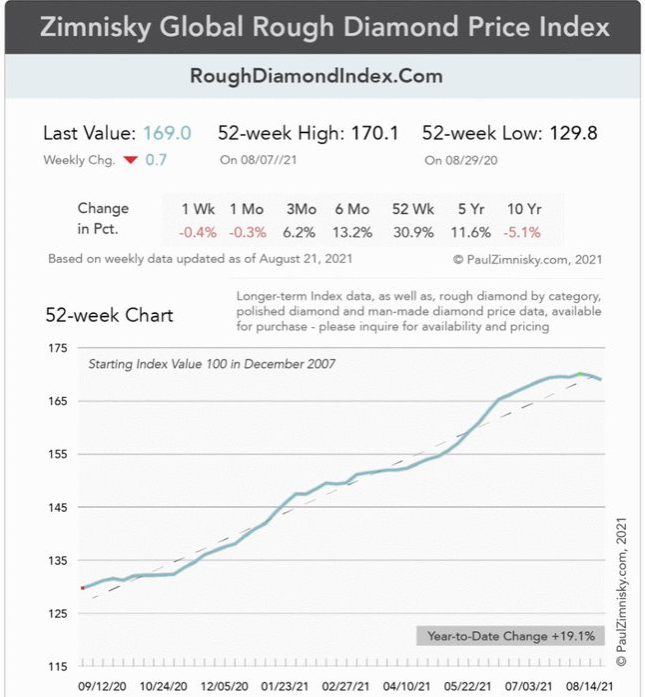The visual identificSince the outbreak of the epidemic, there have been several obvious changes in the international diamond market:
1.The downstream of the industry (retail) first declined and then increased, directly affecting the midstream (processing industry) and upstream (minedrift) of the industry;
2.The market in the post-epidemic era has developed rapidly, helping the midstream and downstream to clear inventory, and forming a market situation where supply exceeds demand;
3.Under the influence of short supply, the prices of rough and finished diamonds have risen one after another, and have exceeded the level before the epidemic.
Especially the price of rough diamonds, after soaring several times, has caused some anxiety in the midstream (and the entire supply chain).
Let's look at a few very representative pictures.
Figure 1: Changes in the price index of rough diamonds in the past year as calculated by Paul Zimnisky

Figure 2: The changes in the price index of rough diamonds from 2008 til 2021 as calculated by Paul Zimnisky.

Figure 3: Bjørnene (Bjørnene) 2020-present 16 sales changes in the fair.

The curve of Alrosa is similar to that of De Beers. The two super giants have a tacit understanding of the market.
We said before that if the entire supply chain is regarded as a whip, then the downstream market is the controlling end of this whip. Through the "swing" of the downstream market, the "fluctuation" of the entire whip is caused, which is called the "bullwhip effect" in economics.

For the diamond industry, after De Beers lost its monopoly, in most cases, the retail side is the only factor that can cause "whip fluctuations". Derfor, whether it is De Beers or other large companies, they have paid great attention to the impact on the downstream market from the beginning. This is also the cause of the "Building Forever" strategy.
But nothing is absolute. In a few cases, the other end of the whip-the upstream can also play the role of "holding the whip", although it is not a real "holding whip" but "active regulation."
Rapaport released a very interesting news two days ago: The Russian National Precious Metals and Gemstone Library (ie the famous Gokhran) has recently experienced a strong output, causing the price index of rough diamonds to fall. Especially in the secondary market, the price of rough diamonds has fallen by 5% in the last month.
Why does Gokhran strongly export rough diamonds to the market? There are two reasons:
1.Alrosa's inventory is really not enough, and the end of the year is approaching. Once the stock is out of stock, the loss will be great;
2.The midstream (processing industry) is complaining about the price of rough diamonds, especially in the secondary market, where the price increase rate has reached 10% (or even a small part approaching 20%). If the midstream loses profit margins, it is likely to cause the entire chain to stagnate.
So I said in two articles about the "super cycle" that Gokhran, the Russian treasury, is like a "regulatory pool", helping to regulate market supply and demand.
This is the embodiment of the "whip-holding" shifting position. Although it is only adjustment and not necessarily long-term, it can play a very important buffering role.
What will happen to the diamond market in the future?
Alrosa has made it clear that in the foreseeable future, the diamond market will always be in a state of "supply in short supply", and the annual supply of rough diamonds will remain at around 120 million carats, and this is a "new normal" .
This is a more sensible and objective view. There are three reasons for this:
1.After experiencing the epidemic, coupled with economic stimulus policies, downstream (terminal) demand will indeed remain strong for a long period of time (the normal off-season is a normal fluctuation);
2.The upstream (mining companies) really cannot supply too much in the short term. Trods alt, the Argyll mine has been closed, and one-fifth of the global supply has been lost. Small mines are basically insignificant, and even restarting old mines such as Ellendale, millions of carats per year will not make much difference. ALROSA has stated that it will increase production by another 5%, reaching a scale of 33 million carats/year, but ALROSA only accounts for 30% of the world's total. De Beers is not as good as Alrosa in terms of production.
3.There is no obvious accumulation of inventory in the midstream (refer to the two articles in the "Super Cycle"), so the momentum of large-scale purchases during peak seasons does not seem to weaken.
But there are two unknowable variables:
1.Can the epidemic be controlled on a large scale?
2.Can Gokhran maintain a large amount of output?
no one knows.
Imidlertid, judging from the current situation, after the price of rough diamonds undergoes adjustment, the possibility of rising is still great. As for the price of (natural) polished diamonds in the terminal, it is basically unlikely to fall under the influence of multiple factors such as shortage of supply and brand effect. As for some people saying that the expansion of cultivated diamonds will cause the price of natural diamonds to fall, this is still a big question mark in my opinion.
